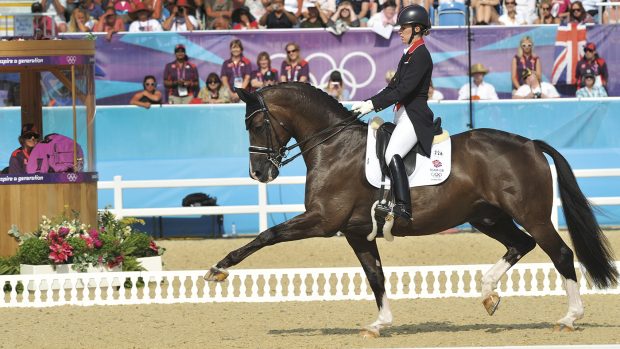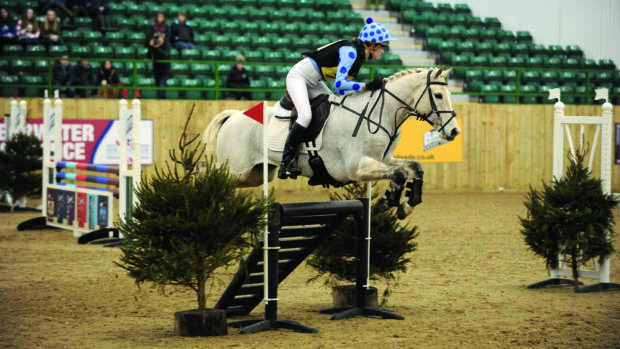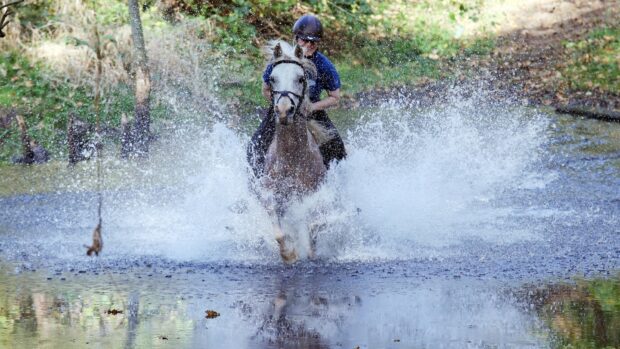You can use the scales of training to self coach and improve your own riding, say two of Britain’s top eventing coaches.
British eventing performance manager Dickie Waygood and coach Chris Bartle talked about this and the importance of the basics in every day training in a webinar published by the Lucinda Green XC Academy, hosted by six-time Badminton Horse Trials winner Lucinda Green.
Dickie spoke about how he encourages riders to incorporate the scales of training – rhythm, suppleness, contact, impulsion, straightness and collection – into their own progress and how you can use them to improve your riding.
“When people come to me and don’t know the scales, I ask them to print three copies and laminate them – one for in their horse box, one for their tack room and one for their bedside locker,” he said.
“You can look at the sales of training just before you ride, or when you’re in the horsebox on the way to a show or before going to bed. You can look through your scales and give yourself a mark for where you are – I got a six today for straightness, so in my training tomorrow, how am I going to make that a 6.5 or a seven? Where am I for rhythm? It keeps fluctating, I’m on a five – so how can I get that to a six?
“So you can use the scales to self coach – it’s a really easy way of using the scales of training, using the basics.”
Lucinda asked what the equivalent was of the scales of training for cross-country performance.
Chris said: “Frankly I think it’s an important point that the word dressage comes from a French word meaning training. The training we want to make our horses effective on the cross-country – to go clear inside the time – that training is very much connecting the three phases. The dressage training that we want to see, the dressage performance we want to see in the arena, is one that’s going to lend itself to that effective cross-country riding and then of course showjumping.
“I keep emphasising that in my cross-country training as much as in the dressage arena, that starting point of the scales of training.”
Dickie added – and Chris agreed – that he would slightly change the order of the scales for event horses: “It’s part of a jigsaw, but for me with an event horse, straightness comes before impulsion in the scales of training because of the nature of what we’re doing with our horses – the back legs following the front legs, even on a circle. That way we know the horse stays on railway tracks and biomechanically can shorten or lengthen.
“We know the horse’s job is to avoid a skinny fence and if they go out through the shoulder, they lose the ability to shorten or lengthen. You see many brave horses glance off fences across country, because their biomechanics will not let them shorten or lengthen when they’re out through their shoulder and not straight.”
Three rules for cross-country
Dickie also spoke about his three rules for cross-country and again how as a competitor, you can use these to improve your riding.
“The rules all have sub paragraphs, but firstly the rider must sit in balance, secondly the rider must put the horse in the correct way of going for the question in hand, and thirdly the rider must provide the line,” he said.
“I hear Chris saying to riders, ‘Which rule did you break?’ So again you can self coach and if you stick to those rules the outcome looks after itself. It’s a simplistic way of looking at it, but it seems to work.”
Dickie also spoke about the fact that the best athletes are not necessarily those with the best technical skills, but those who have the attitude and temperament to follow the system at events.
“You only need enough technical skills to get the job done – if the fence is 3ft high, the horse only needs to clear it by 3ft and half an inch,” he said, mentioning the example of Michael Jung at the Rio Olympics, who did not have a stellar score in any part of his dressage test with La Biosthetique-Sam FBW, but delivered consistency.
“The horse only had so much in his trot, so much in his canter, so much in his walk, but he delivered and just had enough technical skills. But most importantly, both horse and rider had the character to deliver on the field of play under pressure.
“So we go back to you need enough technical skills to get the job done, but that attitude and character is absolutely essential to deliver on any given day of 365 days of the year.”
Dickie added: “If you have a bad day in the office, if you stuck to the system and stuck to the rules and it doesn’t come off that day, you can look yourself in the eye, but if you come away from a competition and you broke the rules, you’ve not stuck to the system, it’s hard to look yourself in the eye. That can take a long time for an athlete to get over, that under pressure they haven’t stuck to the system.”
You might also be interested in:

The scales of training explained for horse riders of all levels

Two jumping exercises to help dressage horses with the winter blues: Dickie Waygood and Laura Collett demo at London

How to retrain a strong horse so you can slow down and stop in a snaffle

10 things successful riders don’t do and you should avoid too

Subscribe to Horse & Hound magazine today – and enjoy unlimited website access all year round
Horse & Hound magazine, out every Thursday, is packed with all the latest news and reports, as well as interviews, specials, nostalgia, vet and training advice. Find how you can enjoy the magazine delivered to your door every week, plus options to upgrade your subscription to access our online service that brings you breaking news and reports as well as other benefits.




